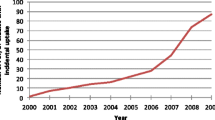Abstract
Background
Positron emission tomography-computed tomography (PET/CT) occasionally reveals unexpected uptake of 18F-fluorodeoxyglucose (18F-FDG) at the gastroesophageal junction (GEJ). The aim of this study was to determine the importance of unexpected 18F-FDG uptake at the GEJ on PET/CT by correlating this finding with endoscopy results.
Methods
We reviewed medical records from June 2009 to October 2012 to identify patients in our Veterans Affairs Medical Center who had an esophagogastroduodenoscopy (EGD) performed within 6 months of a PET/CT. Metabolic activity at the GEJ was quantified with standardized uptake values (SUV) and correlated with EGD and histopathology results.
Results
A total of 219 patients were identified and assigned to one of five groups based upon EGD findings: esophageal malignancy (n = 34), esophagitis (n = 21), Barrett’s esophagus (n = 8), other non-malignant disorders (n = 5), and normal (n = 151). The mean SUVMax for the groups was 6.72, 2.47, 2.40, 3.48, and 2.06, respectively. SUVMax and SUVMean were significantly higher in the esophageal malignancy group than in all other groups (p < 0.001). SUV for patients with high-grade esophagitis was greater than in patients with low-grade esophagitis. A SUVMax ≥3.5 was found to predict necessity for EGD with a positive predictive value of 79 %. A SUVMax ≤2.2 yielded a negative predictive value of 86 %.
Conclusion
Differentiation between benign and potentially significant disease at the GEJ may be possible with quantification of incidental 18F-FDG uptake at PET/CT. Our results suggest thresholds that may help determine need for further endoscopic evaluation in patients with abnormal metabolic activity at the GEJ.






Similar content being viewed by others
References
Cotton PB, Hawes RH, Barkun A, et al. Excellence in endoscopy: toward practical metrics. Gastrointest Endosc. 2006;63:286.
Baus MF, Vaughan TL. Epidemiology and risk factors for gastroesophageal junction tumors: understanding the rising incidence of this disease. SeminRadiatOncol.. 2013;23:3–9.
Lerut T: Carcinoma of the esophagus and gastro-esophageal junction. In: Holzheimer RG, Mannick JA: Surgical Treatment-Evidence-Based and Problem-Oriented. Department of Thoracic Surgery, University of Leuven, Belgium. 2001.
Younes M, Henson DE, Ertan A, Miller CC. Incidence and survival trends of esophageal carcinoma in the United States: racial and gender differences by histological type. Scand J Gastroenterol. 2002;37:1359.
Lightdale CJ. Esophageal cancer. Am J Gastroenterol. 1999;94:20.
Dodds WJ, Dent J, Hogan WJ, et al. Mechanisms of gastroesophageal reflux in patients with reflux esophagitis. N Engl J Med. 1982;307:1547.
Chowhan NM. Injurious effects of radiation on the esophagus. Am J Gastroenterol. 1990;85:115.
Noel RJ, Putnam PE, Rothenberg ME. Eosinophilic esophagitis. N Engl J Med. 2004;351:940.
Morales CP, Souza RF, Spechler SJ. Hallmarks of cancer progression in Barrett’s oesophagus. Lancet. 2002;360:1587.
Kubota K. From tumor biology to clinical PET: a review of positron emission tomography (PET) in oncology. Ann Nucl Med. 2001;15:471–486.
Sathekge M, Maes A, Van de Wiele C. FDG-PET imaging in HIV infection and tuberculosis. SeminNucl Med.. 2013;43:349–366.
Kouijzer IJ, Bleeker-Rovers CP, Oyen WJ. FDG-PET in fever of unknown origin. SeminNucl Med.. 2013;43:333–339.
Shreve PD, Anzai Y, Wahl RL. Pitfalls in oncologic diagnosis with FDG PET imaging: physiologic and benign variants. Radiographics.. 1999;19:61–77.
Gordon BA, Flanagan FL, Dehdashti F. Whole body positron emission tomography: normal variations, pitfalls, and technical considerations. Am J Roentgeno.. 1997;169:1675–1680.
Lowe VJ, Naunheim KS. Positron emission tomography in lung cancer. Ann Thorac Surg. 1998;65:1821.
Asad S, Aquino SL, Piyavisetpat N, Fischman AJ. False-positive FDG positron emission tomography uptake in nonmalignant chest abnormalities. Am J Roentgenol. 2004;182:983–989.
Munden RF, Macapinlac HA, Erasmus JJ. Esophageal cancer: the role of integrated CT-PET in initial staging and response assessment after preoperative therapy. J Thorac Imaging. 2006;21:137–145.
Westerterp M, van Westreenen HL, Reitsma JB, et al. Esophageal cancer: CT, endoscopic US, and FDG PET for assessment of response to neoadjuvant therapy—systematic review. Radiology. 2005;236:841–851.
Tatlidil R, Jadvar H, Bading JR, Conti PS. Incidental colonic fluorodeoxyglucose uptake: correlation with colonoscopic and histopathologic findings. Radiology. 2002;224:783–787.
Tsai MK, Ding HJ, Lai HC, Yen KY, Li CI, Lin YY, Cheng KY, Wang KB, Kao CH. Detection of gastroesophageal reflux esophagitis using 2-fluoro-2-deoxy-d-glucose positron emission tomography. Sci World J. 2012;702803.
Salaun YS, Grewal RK, Dodamane I, Yeung HW, Larson SM, Strauss HW. An analysis of the 18F-FDG uptake pattern in the stomach. J Nucl Med. 2005;46:48–51.
Kamel EM, Thumshirn M, Truninger K, et al. Significance of incidental 18F-FDG accumulations in the gastrointestinal tract in PET/CT: correlation with endoscopic and histopathologic results. J Nucl Med. 2004;45:1804–1810.
Roedl JB, Colen RR, King K, Fischman AJ, Mueller PR, Blake MA. Visual PET/CT scoring for nonspecific 18F-FDG uptake in the differentiation of early malignant and benign esophageal lesions. AJR Am J Roentgenol. 2008;191:515–521.
Jadvar H, Henderson RW, Conti PS. 2-deoxy-2-[F-18]fluoro-d-glucose-positron emission tomography/computed tomography imaging evaluation of esophageal cancer. Mol Imaging Biol.. 2006;8:193–200.
Swisher SG, Maish M, Erasmus JJ, et al. Utility of PET, CT, and EUS to identify pathologic responders in esophageal cancer. Ann Thorac Surg. 2004;78:1152–1160.
Westreenen HL, Plukker JTM, Cobben DCP, Verhoogt CJM, Groen H, Jager PL. Prognostic value of the standardized uptake value in esophageal cancer. Am J Roentgenol. 2005;185:436–440.
Flamen P, Lerut A, Van Cutsem E, et al. Utility of positron emission tomography for the staging of patients with potentially operable esophageal carcinoma. J Clin Oncol. 2000;18:3202.
Flanagan FL, Dehdashti F, Siegel BA, et al. Staging of esophageal cancer with 18F-fluorodeoxyglucose positron emission tomography. Am J Roentgenol. 1997;168:417.
Graham DY, Schwartz JT, Cain GD, Gyorkey F. Prospective evaluation of biopsy number in the diagnosis of esophageal and gastric carcinoma. Gastroenterology. 1982;82:228.
Dent JB, Fendrick AM, Fennerty MB, et al. An evidence based appraisal of reflux disease management—the Genval Workshop Report. Gut. 1999;44:1–16.
Conflict of interest
None.
Author information
Authors and Affiliations
Corresponding author
Rights and permissions
About this article
Cite this article
Stagg, J., Farukhi, I., Lazaga, F. et al. Significance of 18F-Fluorodeoxyglucose Uptake at the Gastroesophageal Junction: Comparison of PET to Esophagogastroduodenoscopy. Dig Dis Sci 60, 1335–1342 (2015). https://doi.org/10.1007/s10620-014-3456-0
Received:
Accepted:
Published:
Issue Date:
DOI: https://doi.org/10.1007/s10620-014-3456-0




